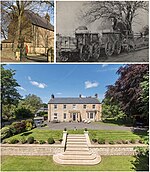Battle of Newburn

The Battle of Newburn, also known as the Battle of Newburn Ford, took place on 28 August 1640, during the Second Bishops' War. It was fought at Newburn, just outside Newcastle, where a ford crossed the River Tyne. A Scottish Covenanter army of 20,000 under Alexander Leslie defeated an English force of 5,000, led by Lord Conway. The only significant military action of the war, victory enabled the Scots to take Newcastle, which provided the bulk of London's coal supplies, and allowed them to put pressure on the central government. The October 1640 Treaty of Ripon agreed the Covenanter army could occupy large parts of northern England, while receiving £850 per day to cover their costs. The Scots insisted Charles recall Parliament to ratify the peace settlement; he did so in November 1640, a key element in the events leading to the First English Civil War in August 1642.
Excerpt from the Wikipedia article Battle of Newburn (License: CC BY-SA 3.0, Authors, Images).Battle of Newburn
Grange Road, Newcastle upon Tyne
Geographical coordinates (GPS) Address Nearby Places Show on map
Geographical coordinates (GPS)
| Latitude | Longitude |
|---|---|
| N 54.983333333333 ° | E -1.7513888888889 ° |
Address
Battle of Newburn Ford 1640
Grange Road
NE15 8NH Newcastle upon Tyne
England, United Kingdom
Open on Google Maps









